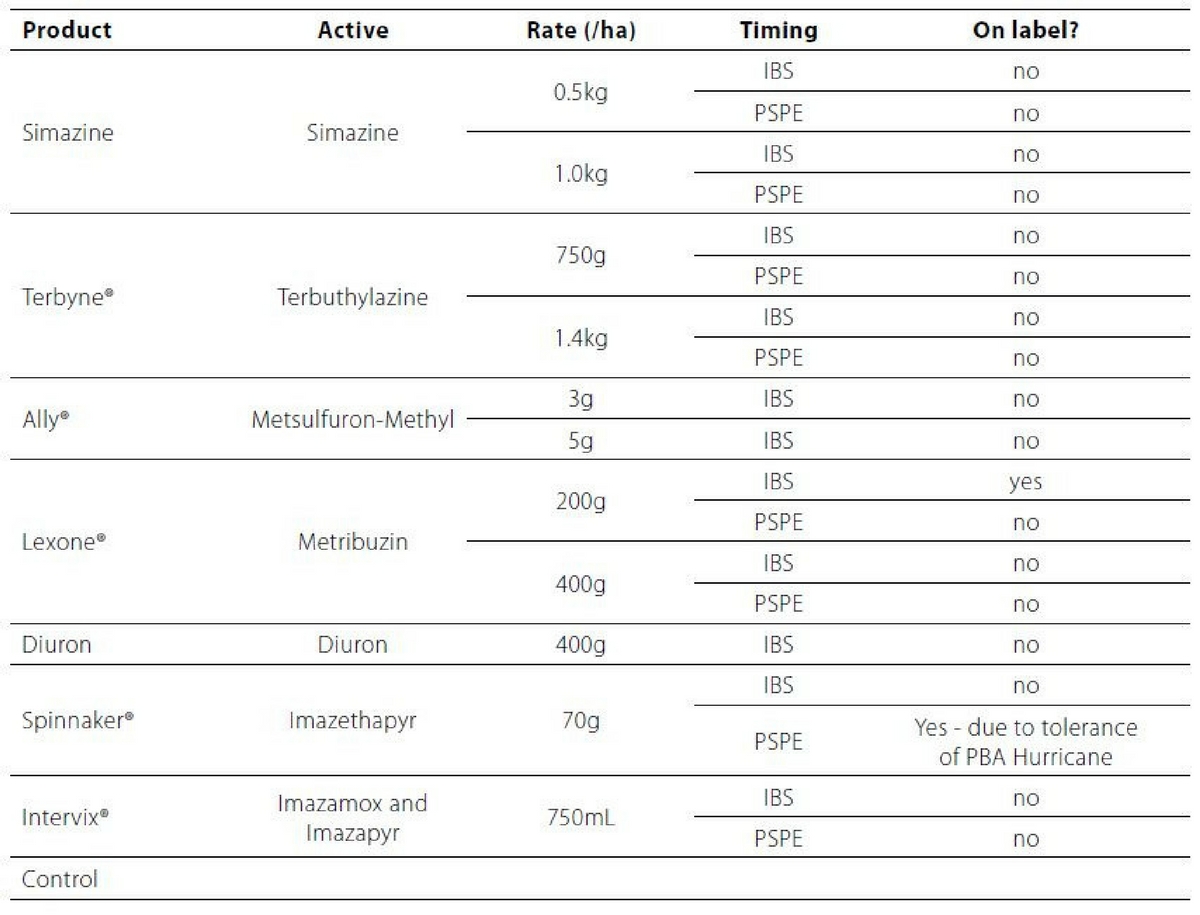Take home messages
- There are limited herbicide options that are safe to use on lentils, particularly on sandy soils.
- Off-label herbicide use can lead to significant crop damage and yield loss.
- Application rate and timing are key factors to reducing herbicide damage in-crop.
Background
As the inclusion of pulses in cropping rotations increases, and with their expansion into new areas, growers and advisors are faced with herbicide challenges on certain soil types, particularly sands. There are limited herbicide options available for use in lentils, hence it is important to understand the crop safety implications and how that is balanced with effective weed control. Metribuzin, whilst being a registered product, can cause unacceptable crop damage on sandier soils. This has led to growers exploring other herbicide options.
Herbicide tolerance in varieties is beneficial for more successful weed control options when growing lentils. The lentil variety PBA Hurricane presents the opportunity for the use of certain Group B herbicides that are not options in other lentil varieties. PBA Hurricane has improved tolerance for residual levels of imidazolinone and sulfonyurea herbicides, tolerance to applied imazethapyr at label rates and improved tolerance to applied flumetsulam. This provides an opportunity to grow lentils with improved weed control options making PBA Hurricane lentils an option for growers in paddocks where problem weeds need to be controlled.
Some of the herbicides used in this trial are not registered for use in lentils or have been applied offlabel, and were tested for experimental purposes only. Always read the label and adhere to directions when using herbicides.
Aim
To determine the effect of herbicide products, rates and application timings (IBS or PSPE) on PBA Hurricane lentil crop safety on a sandy clay loam soil.
Paddock details
| Location: | Curyo |
| Crop year rainfall: | 297mm |
| GSR (Apr-Oct): | 215mm |
| Soil type: | Sandy clay loam |
| Paddock history: | 2016 – fallow, cultivated |
Trials details
| Crop type: | PBA Hurricane lentils |
| Treatments: | Refer to Table 1 |
| Target plant density: | 120 plants/m² |
| Seeding equipment: | Knife points, press wheels, 30cm row spacing |
| Sowing date: | 12 May 2017 |
| Replicates: | Four |
| Harvest date: | 16 November 2017 |
Trials inputs
| Fertiliser: | Granulock® Z + Impact® @ 60kg/ha at sowing |
| Herbicide: | Refer to Table 1 |
| Seed treatment: | P Pickle T @ 200mL/100kg |
| Insect pests and diseases were managed according to best practice. | |
Method
A replicated field trial was sown at Curyo on sandy clay loam soil, a lighter soil than the clay soils traditionally chosen for growing lentils in early years of adoption. The trial was sown using a randomised block design. Assessments included establishment counts, phytotoxicity scoring, weed counts, late season weed scores and grain yield.
Table 1. Treatment outline. Note: Some of the herbicides used in this trial are not registered for use in lentils or have been applied off-label, and were tested for experimental purposes only.
Results and interpretation
Lentils were sown on May 12 and herbicide treatments were applied on the same day both IBS and PSPE. At the time of application the soil was moist following 70mm of rainfall in April. On 18 May 10mm fell at the site followed by another 19mm the next day providing a large amount of post herbicide application rainfall (Figure 1).
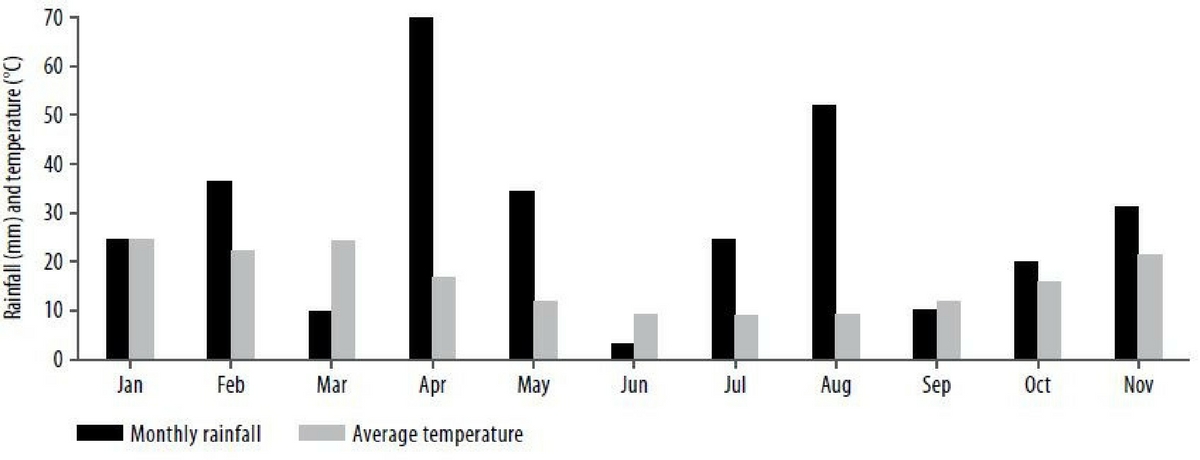
Rainfall and soil moisture conditions can influence herbicide movement through the soil. The degree of movement can be predicted by the solubility of the herbicides i.e. herbicides with low solubility will require more rainfall than highly soluble chemicals to wash through soils (Table 2). The rainfall following sowing may have resulted in herbicides applied IBS being washed into furrows, coming in to contact with some lentil plants.
Table 2. Active, solubility and site of uptake by plants of herbicide products used in this trial.
Establishment
Plant establishment was not even across treatments (Figure 2). In general, lower establishment was observed in treatments that received applications PSPE with the exception of the imi herbicides due to the tolerance of PBA Hurricane lentils. This trend can be explained by lower levels of herbicide-crop contact in IBS applications where herbicide on the soil surface is thrown from furrows to the inter-row following sowing.
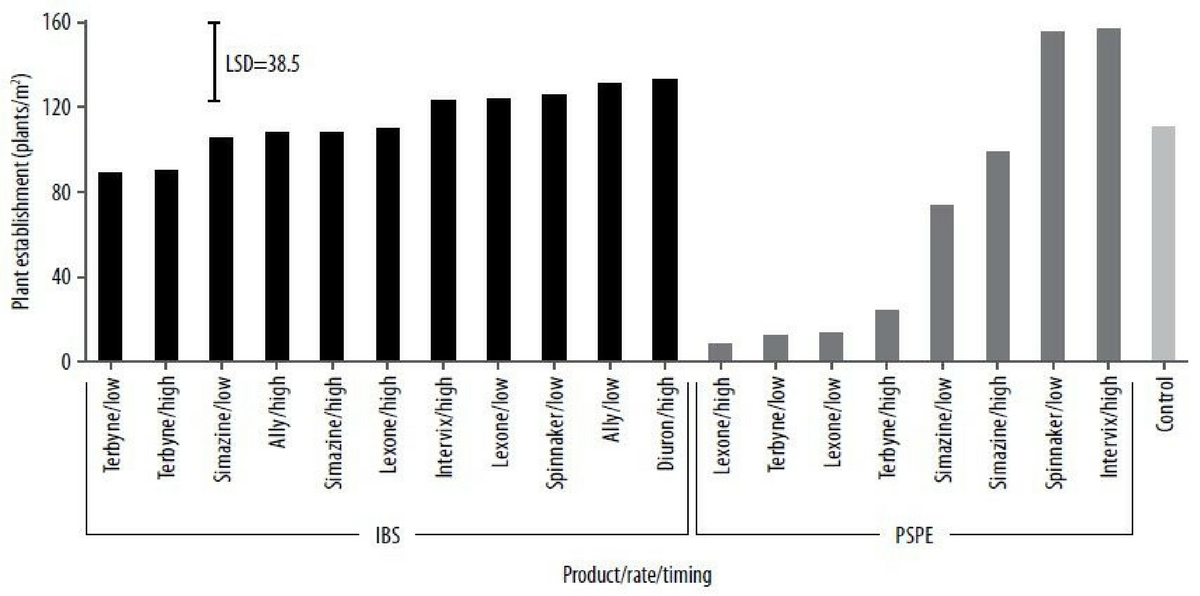
Crop health
Phytotoxicity scores taken five weeks after sowing showed more plant death, and subsequently continued lower plant numbers in treatments with herbicides applied PSPE (Figure 3). Of the treatments applied IBS, the most herbicide damage was observed in Terbyne and Lexone treatments. Across both timings, treatments which received Imidazolinone chemistry showed relatively good plant health due to varietal herbicide tolerance of PBA Hurricane.
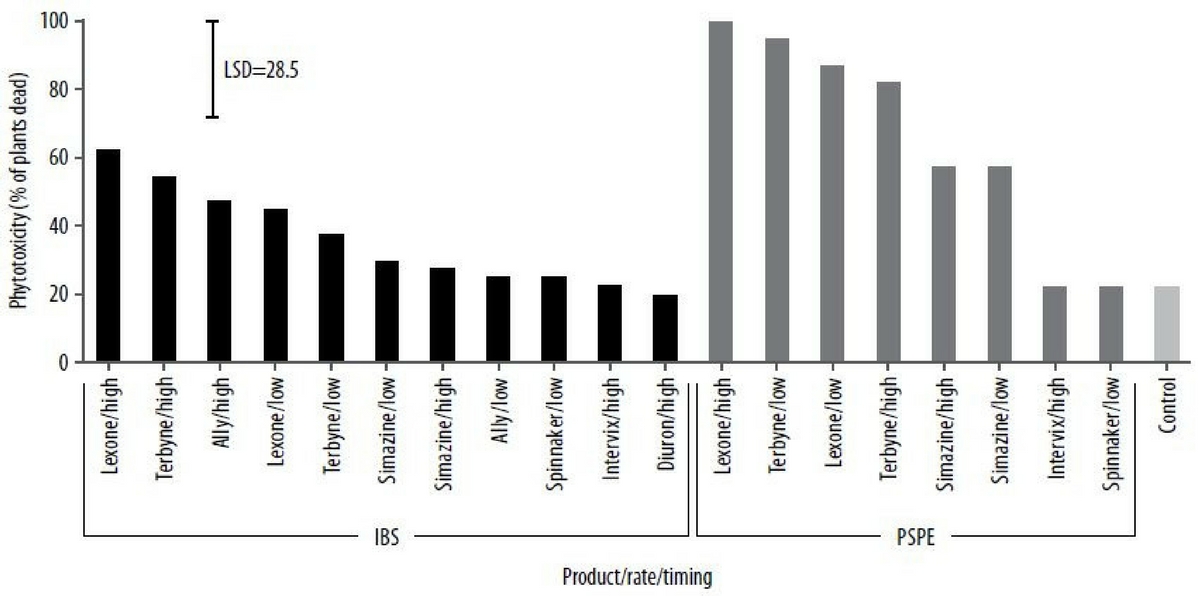
Biomass
Biomass at flowering (GS65) reflected plant establishment and toxicity trends with a generally higher biomass in IBS treatments and where PBA Hurricane has tolerance to the applied chemicals (Figure 4).
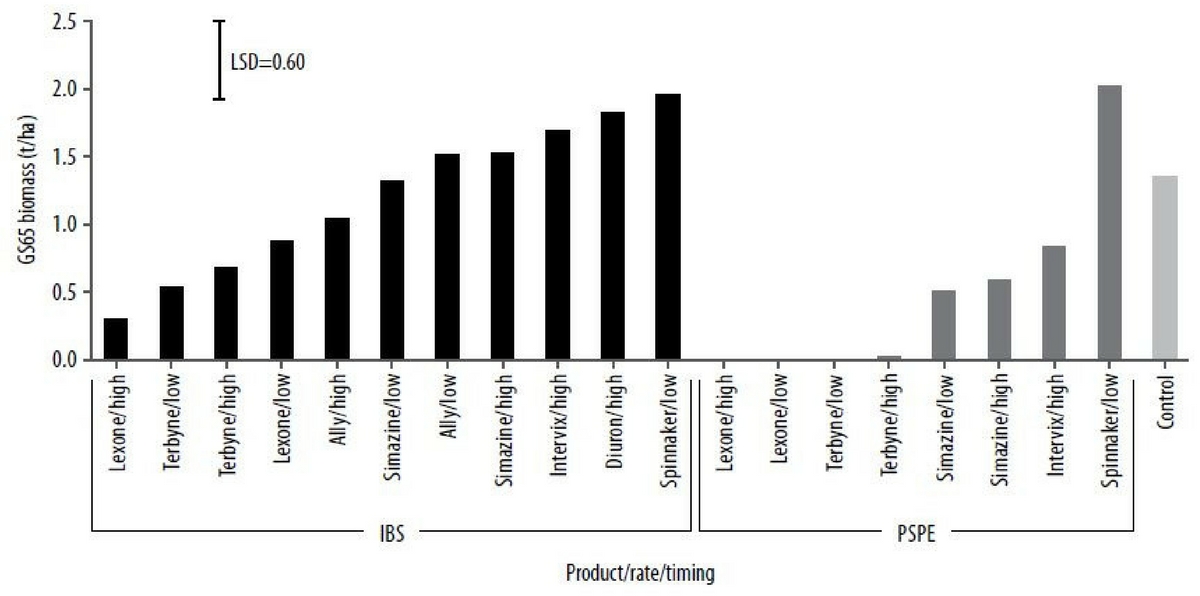
Yield
Potential damage to yield was indicated early in some treatments with low plant establishment numbers and low in-season biomass. This damage was carried through the season and there were significant impacts on grain yield due to herbicide product, rates and timings (Figure 5). A general trend of lower yields was seen when products were applied PSPE, allowing direct contact with the emerging crop.
Terbyne and Lexone applied PSPE did not yield. When applied PSPE (off-label), these herbicides caused irreparable crop damage early in the season.
Terbyne is only registered for IBS application in lentils and warns that phytotoxicity can occur when applied at a high rate. Lighter soils put crops at a greater risk of Terbyne damage along with intense rainfall events where herbicide is washed into the furrow, like those experienced following application in this trial. Although weed control was good, the lower yield in the high rate of Terbyne applied IBS compared to the low rate demonstrates these risks.
Lexone IBS applied treatments also suffered yield loss as a result of chemical damage. Both the high and low rate of applications yielded similarly at around 1t/ha. Lexone application rate is recommended to be lowered on sandy soils however, there was still a detrimental impact on final yield from a low rate application in this trial.
All Simazine treatments, with the exception of the low rate Simazine applied PSPE, were in the highest yielding group of treatments suggesting there was no significant damage to yield from those applications. Simazine at a low rate applied PSPE is likely to have yielded lower than other Simazine treatments due to higher weed competition (Figure 5).
Ally applied IBS resulted in yield loss at both rates. Greater damage was caused to the crop and therefore yield was lower with Ally applied at the higher rate.
Despite having tolerance to Intervix at residual levels, PBA Hurricane yield was affected by the PSPE application of Intervix. This is likely to be a result of the high rate at which it was applied, greater than what would be present as residual levels. A label rate of Spinnaker, to which PBA Hurricane lentils have tolerance, applied PSPE or IBS did not result in any significant yield loss.
As a result of weed competition, the control, with no herbicide applied, struggled to yield well,
suggesting efficient chemical weed control balanced with crop safety did significantly improve yield (Figure 5).
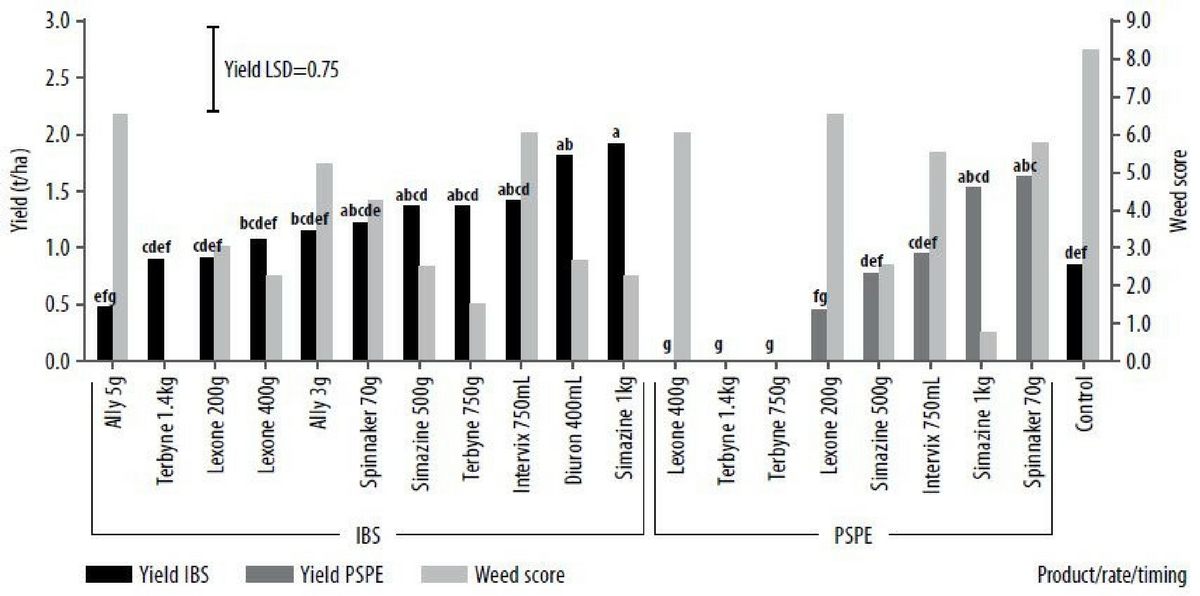
Commercial practice
Limited herbicide options for lentils grown on sandy soils has meant that high yields are often difficult to achieve. Crop safety is of high importance when herbicide choices are made, not only in-crop but also in the previous season and throughout the summer fallow period. Residual levels of some herbicides can have detrimental impacts on lentils sown in a tight cropping rotation.
Off-label chemical use is legal in Victoria however, the implications of applying some herbicides needs to be considered for crop safety purposes.
In general, lower label rates are recommended for use in lighter sandy soils compared with heavier clay soils. This is due to the ability of certain herbicides to bind to clay particles and organic matter more strongly than sand (Congreve and Cameron 2015). Many of the herbicides used in this trial are broken down slowly through microbial action and require rainfall. In some cases significant rainfall amounts are required, depending on solubility, to break down or wash through the soil to below the root systems and sowing depth of plants so crop damage will not occur. Early vigour is closely related to lentil yield (Davey 2014) so ensuring early vigour is not compromised by herbicide residues or applications is important.
Growing herbicide tolerant lentils such as PBA Hurricane presents a safe management option when faced with some of these residual herbicide issues. Of course, understanding the level of tolerance and herbicides to which tolerance exists should be drivers of variety selection for paddocks with known residues. PBA Hurricane is tolerant to residual levels of imidazolinones and label rates of imazethapyr specifically. In this trial, yield was not compromised with a label rate of Imazethapyr (Spinnaker) applied PSPE but, a high rate of Imazamox and Imazapyr (Intervix) applied PSPE resulted in a yield loss, outlining the importance of understanding variety herbicide tolerance levels.
Where off-label herbicide use appears to be safe for use in lentils it is important to consider markets. Lentils are a high value export commodity and, although there is currently no issue with maximum residue limit (MRL) in Australia’s major export market, India, it is always important to consider postharvest marketing options. Would the cost of losing a market be worth the extra yield?
There is a possibility that in the future, more herbicide options will be registered for use in lentils. If these options open up there may be more effective weed control available for use in lentils on sandier soil that do not cause detrimental crop damage. There is a potential for greater weed control and therefore increased yields when growing lentils in the Mallee as these results suggest.
Off-label herbicide use presents increased risks to crop safety that could come at a high cost to growers. There may also be limitations to markets as a result of herbicide MRLs and greater risk of herbicide resistance issues. It is recommended to always adhere to label directives when applying herbicides to a crop, particularly high value crops such as lentils.
References
Davey C, 25 February 2014, Exploring Herbicide Tolerance in Lentils, Accessed 7 January 2018.
Acknowledgements
This project was funded by BCG members through their membership.
